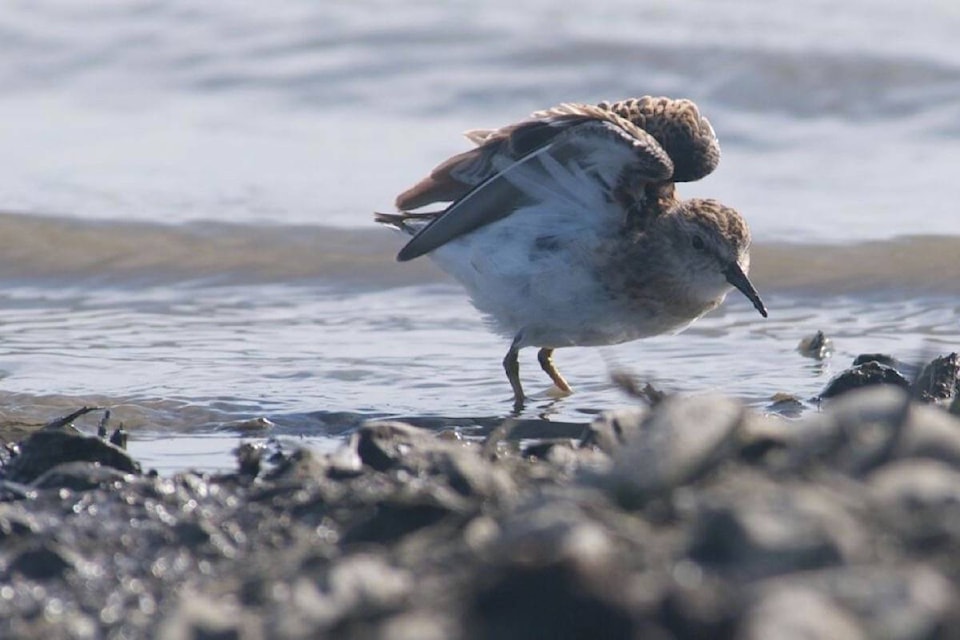Longtime Tofino resident Adrian Dorst is concerned about dogs chasing shorebirds on Chesterman Beach.
Dorst, a wildlife photographer and author of ‘The Birds of Vancouver Island’s West Coast’, has lived on the Pacific Rim since 1972. He told the Westerly Chesterman has always been an important feeding area for shorebirds.
“Chesterman Beach has traditionally been a very important stopover for shorebirds, particularly the south end. The rest of the beach not so much. The shorebirds stop to feed on redworms that live in the sand. About 30 species pass through annually, but as many as 44 species have occurred here,” Dorst wrote in an email.
“In the past, it was common to see flocks of 10,000 or more Western Sandpipers resting on the beach during high tide when the birds like to rest and have a siesta. This would be in August or September. That’s a rarity now.”
He added that “too many people and too many dogs. People we cannot do anything about, but dogs chasing shorebirds is particularly disruptive. This summer was a poor one for shorebirds on Chesterman. Normally, you do not have to be on the beach very long before you see dogs chasing shorebirds,” he continued.
RELATED: Dogs a problem for Vancouver Island shorebirds
RELATED: Shorebird research strengthens push for dog ban at Pacific Rim National Park Reserve
Under Tofino’s Animal Control Bylaw, “all dogs entering and within the Corporation of the District of Tofino shall be under the control of the owner or harbourer and be leashed.” Dorst claims there has been no enforcement of this bylaw at all.
“It’s a free-for-all. Most of the violators are locals, I believe, but there are visitors as well who let their dogs run free,” said Dorst, adding that he has no gripe with dogs being off-leash if they stay close to the owner.
“I used to be a dog owner myself and I like dogs. The problem with [mindful off-leash walks] is that it is very easy to miss seeing some shorebirds because they will often hide near beach debris. By the time you spot them you’re too close,” he said.
Dorst thinks posting signs without enforcement simply does not work.
“Dogs should be banned from the beach outright during the migratory period unless they are with their owner and on a leash. At Long Beach there are now staff members who monitor people with dogs and remind them to have their dog on a leash,” Dorst said.
Coastal Animal Rescue and Education Network co-founder James Rodgers supports enforcing Tofino’s leash law. He said the beaches are just not the same as they were 20 years ago and that the community needs to realistically manage the situation.
“Certainly with how busy our beaches have become and how many dangerous situations have occurred, both for the safety of the shorebirds, the other dogs and the wildlife that we share this place with, having dogs on leash is a good idea,” he said.
“Step one is to have the bylaw enforced. It’s not only going to help the shorebirds, but it’s also going to keep the dogs safe and the people safe,” Rodgers adds.
The spring migration runs primarily from mid-April to mid-May, and the return migration from early July to mid-September, according to Dorst.
“There are still some late birds moving through until the end of May. And in the fall until late October,” said Dorst.
The State of Canada’s Birds 2019 report produced by the North American Bird Conservation Initiative in Canada (NABCI-Canada) revealed shorebirds like the Western Sandpiper are losing ground and have declined by 40 per cent since 1970.
“Shorebirds depend on coastal areas and inland wetlands for breeding, migration, and wintering. Many vital areas are being lost to coastal development and human disturbance,” the Canada’s Birds report states.
Conservation actions recommended by the Canada’s Birds report include protecting migration stopover sites, banning single-use plastics and preventing oil spills.
District of Tofino municipal council once mulled the idea of picking one beach to dedicate as an off-leash dog beach, but couldn’t come to a decision.
Rodgers said CARE Network is currently in discussion with Parks Canada, BC Parks, WildSafe BC, the Districts of Tofino and Ucluelet and surrounding Indigenous communities about how to create more off-leash options for dogs to minimize and reduce wildlife encounters and conflicts.
“Where would that be in terms of real-estate is a big question,” said Rodgers.
He went on to remind dog owners that introductions between dogs on-leash and off-leash should always be done carefully.
“To keep everybody safe, introductions have to be controlled in a mindful way. Often the dogs who are on leash are on leash for good reason. They may be timid around other dogs. They may be fearful or recovering from surgery and under orders to have minimal exercise,” he said.
For more news from Vancouver Island and beyond delivered daily into your inbox, please click here.
nora.omalley@westerlynews.ca
Like us on Facebook and follow us on Twitter
